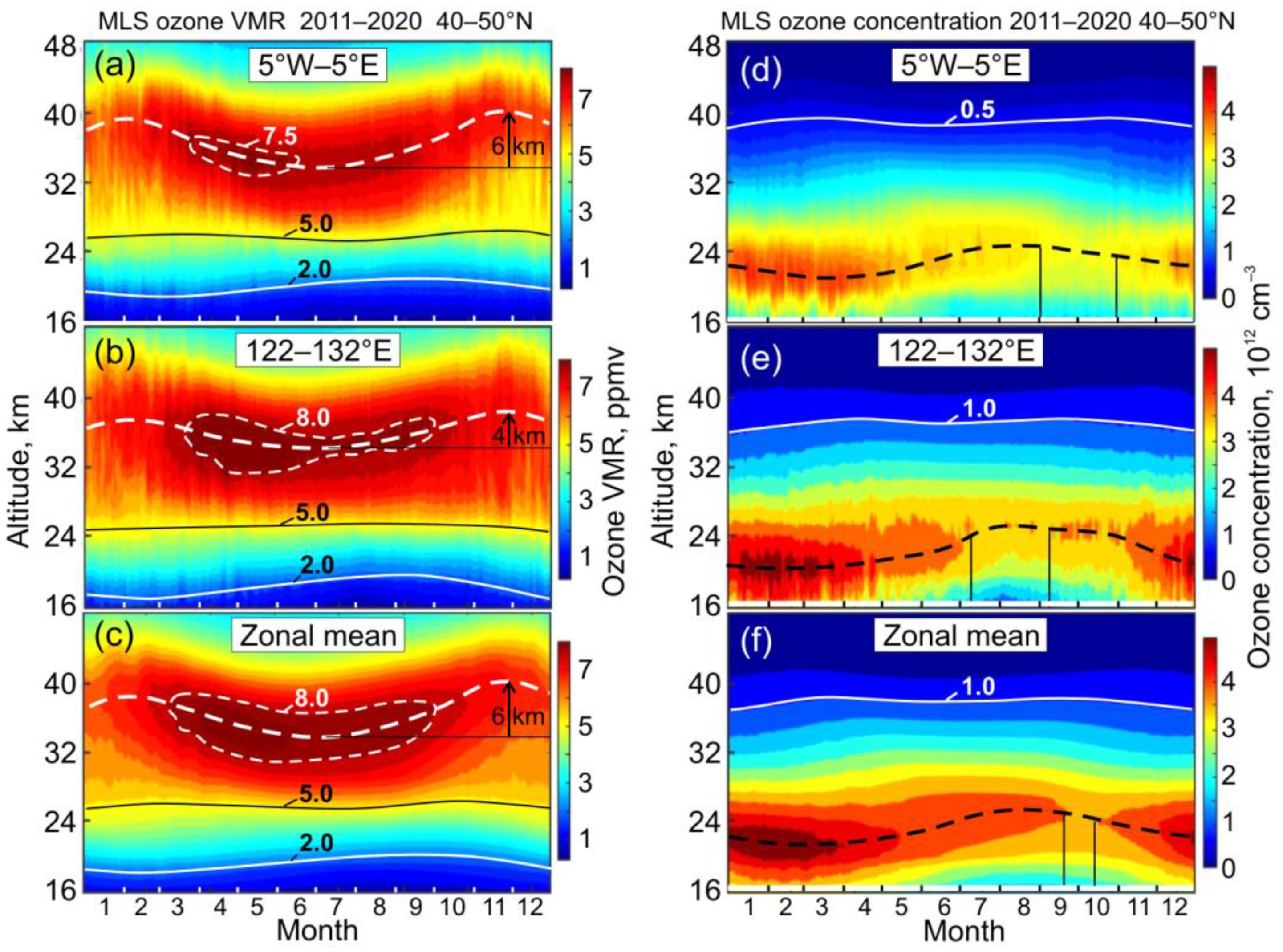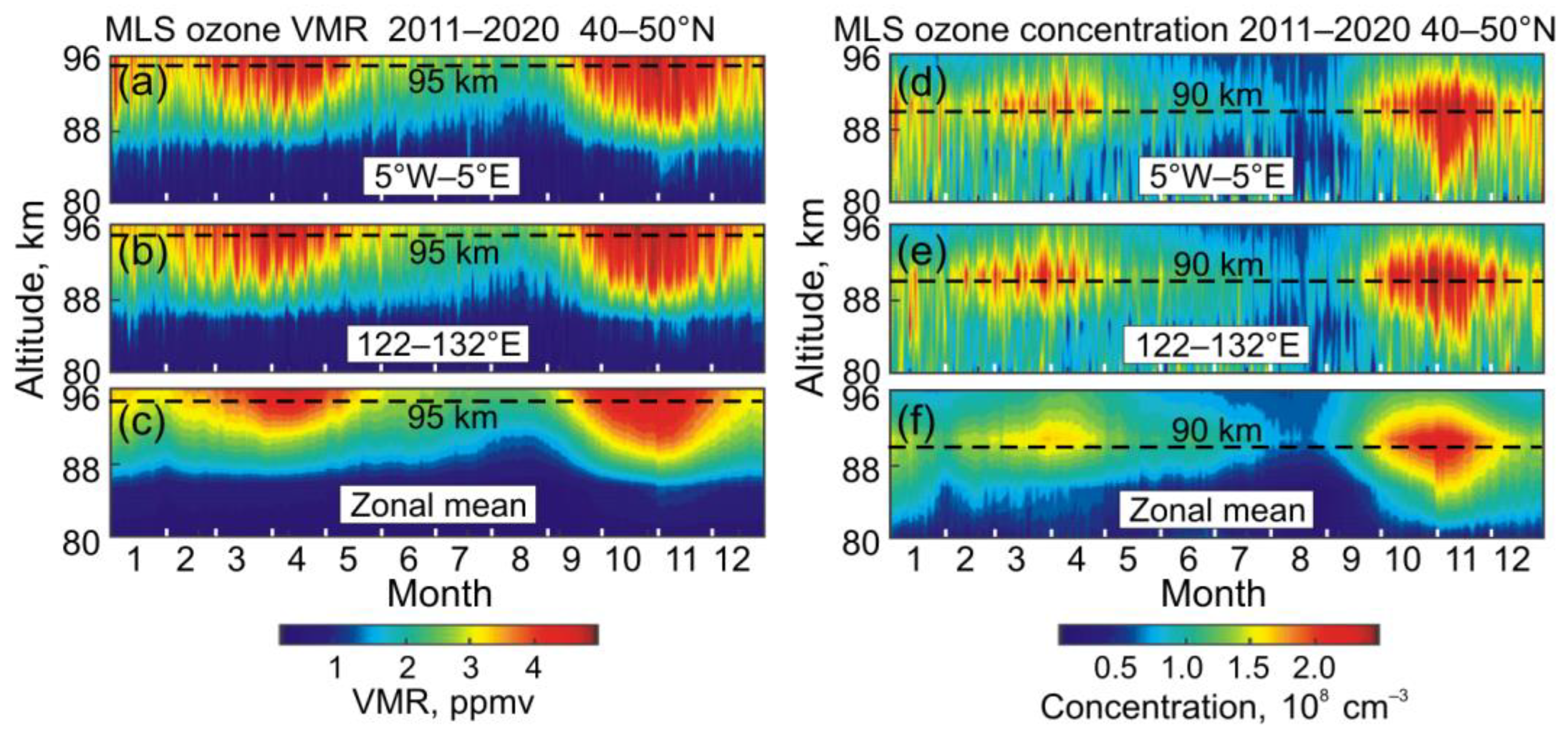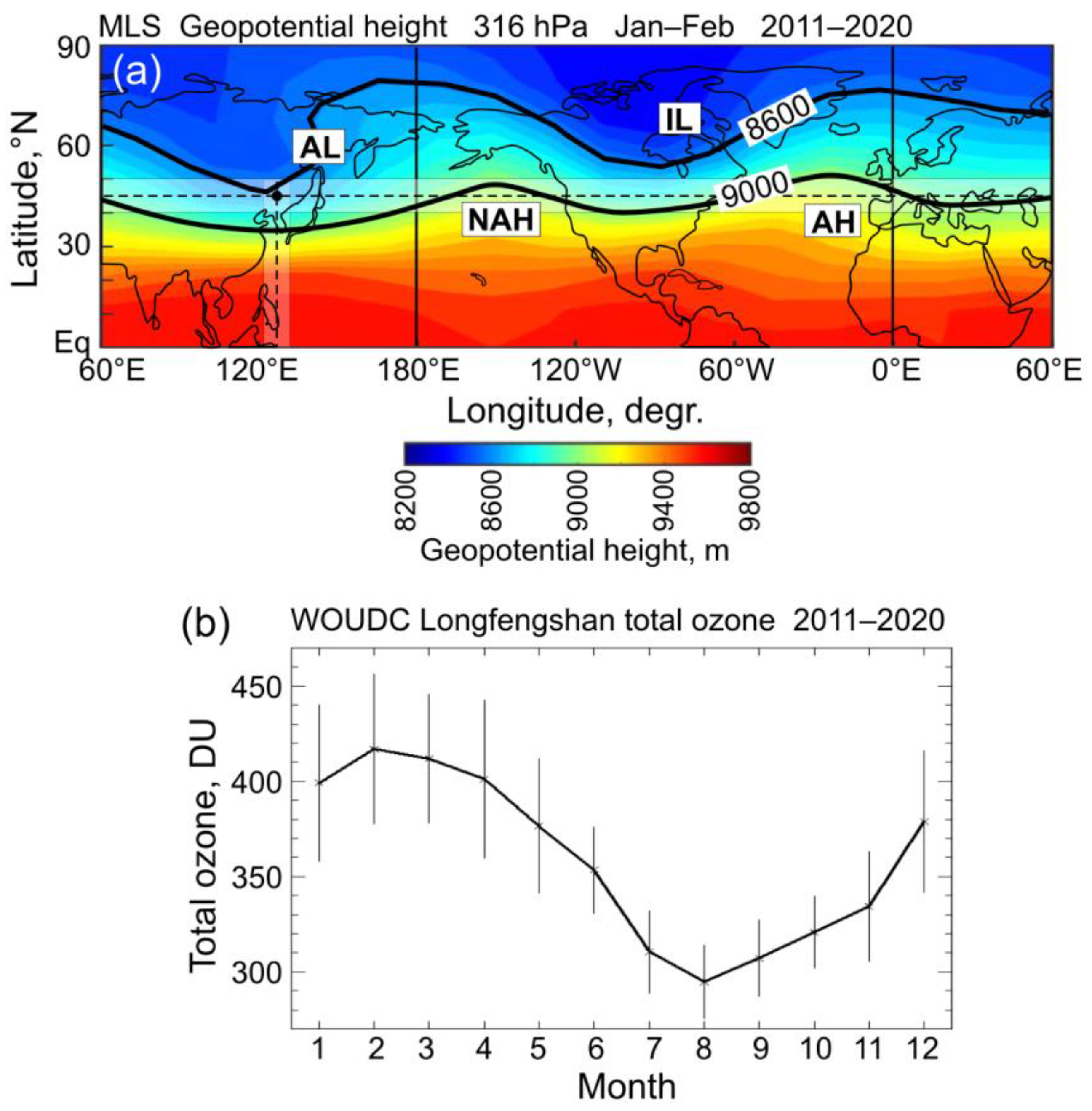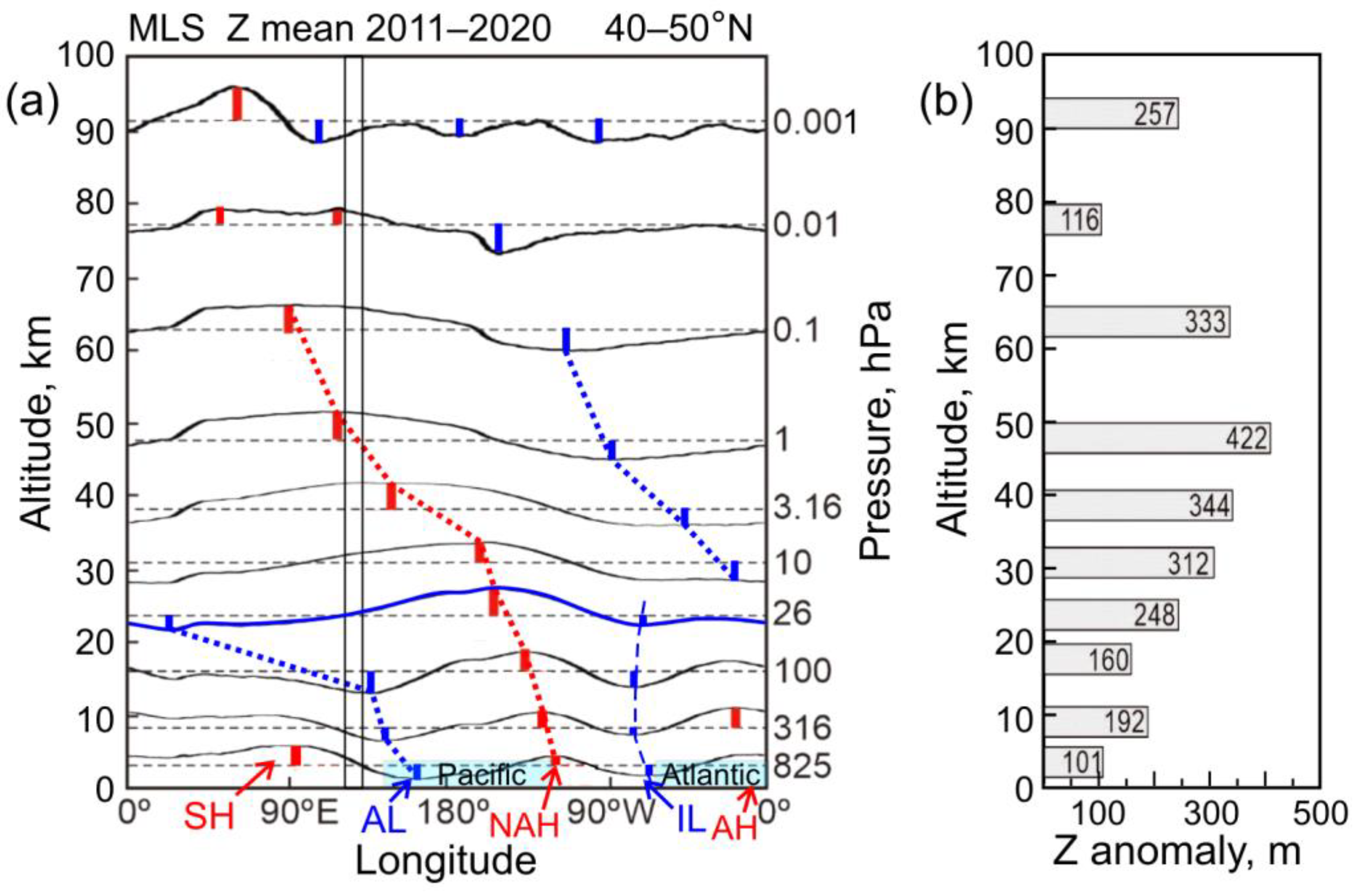The Annual Cycle in Mid-Latitude Stratospheric and Mesospheric Ozone Associated with Quasi-Stationary Wave Structure by the MLS Data 2011–2020
Abstract
1. Introduction
2. Data and Analysis Method
3. QSW Longitudinal Distribution in Geopotential Height and Ozone
3.1. QSW Structure in Geopotential Heights
3.2. QSW Structure in Ozone
4. Annual Variations in the Stratospheric and Mesospheric Ozone



5. Discussion
5.1. Correlation between Zonal Anomalies in Geopotential Height and Ozone
5.2. Annual Cycle in Stratospheric Ozone
5.3. Annual Cycle in Mesospheric Ozone
6. Conclusions
Author Contributions
Funding
Acknowledgments
Conflicts of Interest
References
- Wirth, V. Quasi-stationary planetary waves in total ozone and their correlation with lower stratospheric temperature. J. Geophys. Res. 1998, 98, 8873–8882. [Google Scholar] [CrossRef]
- Gabriel, A.; Körnich, H.; Lossow, S.; Peters, D.H.W.; Urban, J.; Murtagh, D. Zonal asymmetries in middle atmospheric ozone and water vapour derived from Odin satellite data 2001–2010. Atmos. Chem. Phys. 2011, 11, 9865–9885. [Google Scholar] [CrossRef]
- Wills, R.C.J.; White, R.H.; Levine, X.J. Northern Hemisphere stationary waves in a changing climate. Curr. Clim. Chang. Rep. 2019, 5, 372–389. [Google Scholar] [CrossRef]
- Charney, J.G.; Drazin, P.G. Propagation of planetary-scale disturbances from the lower into the upper atmosphere. J. Geophys. Res. 1961, 66, 83–109. [Google Scholar] [CrossRef]
- Stray, N.H.; Orsolini, Y.J.; Espy, P.J.; Limpasuvan, V.; Hibbins, R.E. Observations of planetary waves in the mesosphere–lower thermosphere during stratospheric warming events. Atmos. Chem. Phys. 2015, 15, 4997–5005. [Google Scholar] [CrossRef]
- Matsuno, T. Vertical propagation of stationary planetary waves in the winter Northern Hemisphere. J. Atmos. Sci. 1970, 27, 871–883. [Google Scholar] [CrossRef]
- Hood, L.L.; Zaff, D.A. Lower stratospheric stationary waves and the longitude dependence of ozone trends in winter. J. Geophys. Res. 1995, 100, 25791–25800. [Google Scholar] [CrossRef]
- Wolf, G.; Brayshaw, D.J.; Klingaman, N.P.; Czaja, A. Quasi-stationary waves and their impact on European weather and extreme events. Q. J. R. Meteorol. Soc. 2018, 144, 2431–2448. [Google Scholar] [CrossRef]
- Eck, T.F.; Bhartia, P.K.; Kerr, J.B. Satellite estimation of spectral UVB irradiance using TOMS derived total ozone and UV reflectivity. Geophys. Res. Lett. 1995, 22, 611–614. [Google Scholar] [CrossRef]
- Kazantzidis, A.; Bais, A.F.; Gröbner, J.; Herman, J.R.; Kazadzis, S.; Krotkov, N.; Kyrö, E.; den Outer, P.N.; Garane, K.; Görts, P.; et al. Comparison of satellite-derived UV irradiances with ground-based measurements at four European stations. J. Geophys. Res. 2006, 111, D13207. [Google Scholar] [CrossRef]
- Kim, J.; Cho, H.-K.; Mok, J.; Yoo, H.D.; Cho, N.S. Effects of ozone and aerosol on surface UV radiation variability. J. Photochem. Photobiol. B Biol. 2013, 119, 46–51. [Google Scholar] [CrossRef] [PubMed]
- Garfinkel, C.I.; White, I.; Gerber, E.P.; Son, S.-W.; Jucker, M. Stationary wave and surface radiative effects weaken and delay the near-surface response to stratospheric ozone depletion. Earth Space Sci. Open Arch. 2021, 40. [Google Scholar] [CrossRef]
- Fountoulakis, I.; Diémoz, H.; Siani, A.M.; di Sarra, A.; Meloni, D.; Sferlazzo, D.M. Variability and trends in surface solar spectral ultraviolet irradiance in Italy: On the influence of geopotential height and lower-stratospheric ozone. Atmos. Chem. Phys. 2021, 21, 18689–18705. [Google Scholar] [CrossRef]
- Huang, F.T.; Mayr, H.G.; Russell, J.M., III; Mlynczak, M.G. Ozone and temperature decadal trends in the stratosphere, mesosphere and lower thermosphere, based on measurements from SABER on TIMED. Ann. Geophys. 2014, 32, 935–949. [Google Scholar] [CrossRef]
- Matthias, V.; Ern, M. On the origin of the mesospheric quasi-stationary planetary waves in the unusual Arctic winter 2015/2016. Atmos. Chem. Phys. 2018, 18, 4803–4815. [Google Scholar] [CrossRef]
- Efstathiou, M.N.; Varotsos, C.A.; Singh, R.P.; Cracknell, A.P.; Tzanis, C. On the longitude dependence of total ozone trends over middle-latitudes. Int. J. Remote Sens. 2003, 24, 1361–1367. [Google Scholar] [CrossRef]
- Nikulin, G.; Karpechko, A. The mean meridional circulation and midlatitude ozone buildup. Atmos. Chem. Phys. 2005, 5, 3159–3172. [Google Scholar] [CrossRef]
- Peters, D.H.W.; Gabriel, A.; Entzian, G. Longitude-dependent decadal ozone changes and ozone trends in boreal winter months during 1960–2000. Ann. Geophys. 2008, 26, 1275–1286. [Google Scholar] [CrossRef]
- Demirhan Bari, D.; Gabriel, A.; Körnich, H.; Peters, D.W.H. The effect of zonal asymmetries in the Brewer-Dobson circulation on ozone and water vapor distributions in the northern middle atmosphere. J. Geophys. Res. Atmos. 2013, 118, 3447–3466. [Google Scholar] [CrossRef]
- Waugh, D.W.; Randel, W.J. Climatology of Arctic and Antarctic polar vortices using elliptical diagnostics. J. Atmos. Sci. 1999, 56, 1594–1613. [Google Scholar] [CrossRef]
- Grytsai, A.V.; Evtushevsky, O.M.; Agapitov, O.V.; Klekociuk, A.R.; Milinevsky, G.P. Structure and long-term change in the zonal asymmetry in Antarctic total ozone during spring. Ann. Geophys. 2007, 25, 361–374. [Google Scholar] [CrossRef][Green Version]
- Salby, M.L.; Callaghan, P.F. Interannual changes of the stratospheric circulation: Relationship to ozone and tropospheric structure. J. Clim. 2002, 15, 3673–3685. [Google Scholar] [CrossRef]
- Sekiguchi, Y.; Kida, H. The seasonal variation of total ozone amount in middle latitudes. J. Meteorol. Soc. Jpn. 1971, 49, 95–110. [Google Scholar] [CrossRef][Green Version]
- Rieder, H.E.; Jancso, L.M.; Di Rocco, S.; Staehelin, J.; Maeder, J.A.; Peter, T.; Ribatet, M.; Davison, A.C.; De Backer, H.; Koehler, U.; et al. Extreme events in total ozone over the Northern mid-latitudes: An analysis based on long-term data sets from five European ground-based stations. Tellus B 2011, 63, 860–874. [Google Scholar] [CrossRef]
- Bowman, K.P.; Krueger, A.J. A global climatology of total ozone from the Nimbus 7 total ozone mapping spectrometer. J. Geophys. Res. 1985, 90, 7967–7976. [Google Scholar] [CrossRef]
- Fioletov, V.E.; Shepherd, T.G. Seasonal persistence of midlatitude total ozone anomalies. Geophys. Res. Lett. 2003, 30, 1417. [Google Scholar] [CrossRef]
- Miyazaki, K.; Iwasaki, T.; Shibata, K.; Deushi, M. Roles of transport in the seasonal variation of the total ozone amount. J. Geophys. Res. 2005, 110, D18309. [Google Scholar] [CrossRef]
- Tegtmeier, S.; Fioletov, V.E.; Shepherd, T.G. A global picture of the seasonal persistence of stratospheric ozone anomalies. J. Geophys. Res. 2010, 115, D18119. [Google Scholar] [CrossRef]
- Coldewey-Egbers, M.; Loyola, D.G.; Labow, G.; Frith, S.M. Comparison of GTO-ECV and adjusted MERRA-2 total ozone columns from the last 2 decades and assessment of interannual variability. Atmos. Meas. Tech. 2020, 13, 1633–1654. [Google Scholar] [CrossRef]
- Krzyścin, J.W.; Rajewska-Więch, B.; Jarosławski, J. The long-term variability of atmospheric ozone from the 50-yr observations carried out at Belsk (51.84°N, 20.78°E), Poland. Tellus B 2013, 65, 21779. [Google Scholar] [CrossRef]
- Eleftheratos, K.; Kouklaki, D.; Zerefos, C. Sixteen years of measurements of ozone over Athens, Greece with a Brewer spectrophotometer. Oxygen 2021, 1, 32–45. [Google Scholar] [CrossRef]
- Iwasaki, T.; Kaneto, S. Photochemical and dynamical contributions to the seasonal variation of total ozone amount over Japan. J. Meteorol. Soc. Jpn. 1984, 62, 343–356. [Google Scholar] [CrossRef][Green Version]
- Antón, M.; Bortoli, D.; Costa, M.J.; Kulkarni, P.S.; Domingues, A.F.; Barriopedro, D.; Serrano, A.; Silva, A.M. Temporal and spatial variabilities of total ozone column over Portugal. Remote Sens. Environ. 2011, 115, 855–863. [Google Scholar] [CrossRef]
- Zou, H.; Zhou, L.; Gao, Y.; Chen, X.; Li, P.; Ji, C.; Ma, S.; Gao, D. Total ozone variation between 50° and 60°N. Geophys. Res. Lett. 2005, 32, L23812. [Google Scholar] [CrossRef]
- Evtushevsky, O.; Grytsai, A.; Milinevsky, G. On the regional distinctions in annual cycle of total ozone in the northern midlatitudes. Remote Sens. Lett. 2014, 5, 205–212. [Google Scholar] [CrossRef]
- Zhang, J.; Tian, W.; Xie, F.; Sang, W.; Guo, D.; Chipperfield, M.; Feng, W.; Hu, D. Zonally asymmetric trends of winter total column ozone in the northern middle latitudes. Clim. Dyn. 2019, 52, 4483–4500. [Google Scholar] [CrossRef]
- Livesey, N.J.; Read, W.G.; Wagner, P.A.; Froidevaux, L.; Lambert, A.; Manney, G.L.; Millán Valle, L.F.; Pumphrey, H.C.; Santee, M.L.; Schwartz, M.J.; et al. Version 4.2x Level 2 and 3 Data Quality and Description Document; Jet Propulsion Laboratory: Pasadena, CA, USA, 2020; 174p. Available online: https://mls.jpl.nasa.gov/data/v4-2_data_quality_document.pdf (accessed on 20 January 2022).
- Xu, X.; Manson, A.H.; Meek, C.E.; Chshyolkova, T.; Drummond, J.R.; Hall, C.M.; Riggin, D.M.; Hibbins, R.E. Vertical and interhemispheric links in the stratosphere-mesosphere as revealed by the day-to-day variability of Aura-MLS temperature data. Ann. Geophys. 2009, 27, 3387–3409. [Google Scholar] [CrossRef][Green Version]
- Schwartz, M.; Livesey, N.; Read, W. MLS/Aura Level 2 Geopotential Height V004, Greenbelt, MD, USA, Goddard Earth Sciences Data and Information Services Center (GES DISC). 2015. Available online: https://disc.gsfc.nasa.gov/datasets/ML2GPH_004/summary/ (accessed on 9 February 2022).
- Schwartz, M.; Froidevaux, L.; Livesey, N.; Read, W. MLS/Aura Level 2 Ozone (O3) Mixing Ratio V004, Greenbelt, MD, USA, Goddard Earth Sciences Data and Information Services Center (GES DISC). 2015. Available online: https://disc.gsfc.nasa.gov/datasets/ML2O3_004/summary/ (accessed on 15 December 2021).
- Wang, Y.; Shulga, V.; Milinevsky, G.; Patoka, A.; Evtushevsky, O.; Klekociuk, A.; Han, W.; Grytsai, A.; Shulga, D.; Myshenko, V.; et al. Winter 2018 major sudden stratospheric warming impact on midlatitude mesosphere from microwave radiometer measurements. Atmos. Chem. Phys. 2019, 19, 10303–10317. [Google Scholar] [CrossRef]
- Shi, Y.; Shulga, V.; Ivaniha, O.; Wang, Y.; Evtushevsky, O.; Milinevsky, G.; Klekociuk, A.; Patoka, A.; Han, W.; Shulga, D. Comparison of major sudden stratospheric warming impacts on the mid-latitude mesosphere based on local microwave radiometer CO observations in 2018 and 2019. Remote Sens. 2020, 12, 3950. [Google Scholar] [CrossRef]
- WOUDC: The World Ozone and Ultraviolet Radiation Data Centre, Longfengshan Station, ID 326, Brewer Spectrophotometer, China. Available online: https://woudc.org/data/explore.php# (accessed on 9 February 2022).
- Hoinka, K.P. Statistics of the global tropopause pressure. Mon. Weather Rev. 1998, 126, 3303–3325. [Google Scholar] [CrossRef]
- Harvey, V.L.; Hitchman, M.H. A climatology of the Aleutian High. J. Atmos. Sci. 1996, 53, 2088–2102. [Google Scholar] [CrossRef]
- Kosaka, Y.; Nakamura, H. Mechanisms of meridional teleconnection observed between a summer monsoon system and a subtropical anticyclone. Part I: The Pacific–Japan pattern. J. Clim. 2010, 23, 5085–5108. [Google Scholar] [CrossRef]
- Boville, B.W. The Aleutian stratospheric anticyclone. J. Atmos. Sci. 1960, 17, 329–336. [Google Scholar] [CrossRef][Green Version]
- France, J.A.; Harvey, V.L.; Randall, C.E.; Hitchman, M.H.; Schwartz, M.J. A climatology of stratopause temperature and height in the polar vortex and anticyclones. J. Geophys. Res. 2012, 117, D06116. [Google Scholar] [CrossRef]
- Serreze, M.C.; Carse, F.; Barry, R.G.; Rogers, J.C. Icelandic Low cyclone activity: Climatological features, linkages with the NAO, and relationships with recent changes in the Northern Hemisphere circulation. J. Clim. 1997, 10, 453–464. [Google Scholar] [CrossRef]
- Nigam, S.; DeWeaver, E. Stationary waves (orographic and thermally forced). In Encyclopedia of Atmospheric Sciences; James, R.H., Pyle, J., Judith, A.C., Eds.; Academic Press: Cambridge, MA, USA; Elsevier Science: London, UK, 2003; pp. 2121–2137. [Google Scholar] [CrossRef]
- Volodin, E.M.; Schmitz, G. A troposphere–stratosphere–mesosphere general circulation model with parameterization of gravity waves: Climatology and sensitivity studies. Tellus A Dyn. Meteorol. Oceanogr. 2001, 53, 300–316. [Google Scholar] [CrossRef][Green Version]
- France, J.A.; Harvey, V.L.; Randall, C.E.; Collins, R.L.; Smith, A.K.; Peck, E.D.; Fang, X. A climatology of planetary wave-driven mesospheric inversion layers in the extratropical winter. J. Geophys. Res. Atmos. 2015, 120, 399–413. [Google Scholar] [CrossRef]
- Smith, A.K. Stationary planetary waves in upper mesospheric winds. J. Atmos. Sci. 1997, 54, 2129–2145. [Google Scholar] [CrossRef]
- Sugita, T.; Nakajima, H.; Yokota, T.; Kanzawa, H.; Gernandt, H.; Herber, A.; von der Gathen, P.; König-Langlo, G.; Sato, K.; Dorokhov, V.; et al. Ozone profiles in the high-latitude stratosphere and lower mesosphere measured by the Improved Limb Atmospheric Spectrometer (ILAS)-II: Comparison with other satellite sensors and ozonesondes. J. Geophys. Res. 2006, 111, D11S02. [Google Scholar] [CrossRef]
- Maeda, K. Annual and semiannual oscillations of stratospheric ozone. Pure Appl. Geophys. 1987, 125, 147–165. [Google Scholar] [CrossRef]
- Moreira, L.; Hocke, K.; Navas-Guzmán, F.; Eckert, E.; von Clarmann, T.; Kämpfer, N. The natural oscillations in stratospheric ozone observed by the GROMOS microwave radiometer at the NDACC station Bern. Atmos. Chem. Phys. 2016, 16, 10455–10467. [Google Scholar] [CrossRef]
- Joshi, V.; Sharma, S.; Kumar, K.N.; Patel, N.; Kumar, P.; Bencherif, H.; Ghosh, P.; Jethva, C.; Vaishnav, R. Analysis of the middle atmospheric ozone using SABER observations: A study over mid-latitudes in the northern and southern hemispheres. Clim. Dyn. 2020, 54, 2481–2492. [Google Scholar] [CrossRef]
- Dütsch, H.U. The ozone distribution in the atmosphere. Can. J. Chem. 1974, 52, 1491–1504. [Google Scholar] [CrossRef]
- Prather, M.J. Ozone in the upper stratosphere and mesosphere. J. Geophys. Res. 1981, 86, 5325–5338. [Google Scholar] [CrossRef]
- Tummon, F.; Hassler, B.; Harris, N.R.P.; Staehelin, J.; Steinbrecht, W.; Anderson, J.; Bodeker, G.E.; Bourassa, A.; Davis, S.M.; Degenstein, D.; et al. Intercomparison of vertically resolved merged satellite ozone data sets: Interannual variability and long-term trends. Atmos. Chem. Phys. 2015, 15, 3021–3043. [Google Scholar] [CrossRef]
- Smith, A.K.; Marsh, D.R. Processes that account for the ozone maximum at the mesopause. J. Geophys. Res. 2005, 110, D23305. [Google Scholar] [CrossRef]
- Huang, F.T.; Mayr, H.G.; Reber, C.A.; Russell, J.M., III; Mlynczak, M.G.; Mengel, J.G. Ozone quasi-biennial oscillations (QBO), semiannual oscillations (SAO), and correlations with temperature in the mesosphere, lower thermosphere, and stratosphere, based on measurements from SABER on TIMED and MLS on UARS. J. Geophys. Res. 2008, 113, A01316. [Google Scholar] [CrossRef]
- Smith, A.K. The origin of stationary planetary waves in the upper mesosphere. J. Atmos. Sci. 2003, 60, 3033–3041. [Google Scholar] [CrossRef]



Publisher’s Note: MDPI stays neutral with regard to jurisdictional claims in published maps and institutional affiliations. |
© 2022 by the authors. Licensee MDPI, Basel, Switzerland. This article is an open access article distributed under the terms and conditions of the Creative Commons Attribution (CC BY) license (https://creativecommons.org/licenses/by/4.0/).
Share and Cite
Zhang, C.; Evtushevsky, O.; Milinevsky, G.; Klekociuk, A.; Andrienko, Y.; Shulga, V.; Han, W.; Shi, Y. The Annual Cycle in Mid-Latitude Stratospheric and Mesospheric Ozone Associated with Quasi-Stationary Wave Structure by the MLS Data 2011–2020. Remote Sens. 2022, 14, 2309. https://doi.org/10.3390/rs14102309
Zhang C, Evtushevsky O, Milinevsky G, Klekociuk A, Andrienko Y, Shulga V, Han W, Shi Y. The Annual Cycle in Mid-Latitude Stratospheric and Mesospheric Ozone Associated with Quasi-Stationary Wave Structure by the MLS Data 2011–2020. Remote Sensing. 2022; 14(10):2309. https://doi.org/10.3390/rs14102309
Chicago/Turabian StyleZhang, Chenning, Oleksandr Evtushevsky, Gennadi Milinevsky, Andrew Klekociuk, Yulia Andrienko, Valery Shulga, Wei Han, and Yu Shi. 2022. "The Annual Cycle in Mid-Latitude Stratospheric and Mesospheric Ozone Associated with Quasi-Stationary Wave Structure by the MLS Data 2011–2020" Remote Sensing 14, no. 10: 2309. https://doi.org/10.3390/rs14102309
APA StyleZhang, C., Evtushevsky, O., Milinevsky, G., Klekociuk, A., Andrienko, Y., Shulga, V., Han, W., & Shi, Y. (2022). The Annual Cycle in Mid-Latitude Stratospheric and Mesospheric Ozone Associated with Quasi-Stationary Wave Structure by the MLS Data 2011–2020. Remote Sensing, 14(10), 2309. https://doi.org/10.3390/rs14102309








